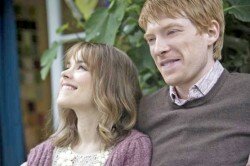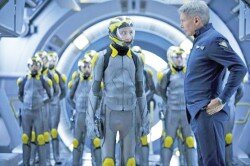About Time
![]()
About Time
![]()
Runtime 125 minutes.
OK for children.
Raindrops on roses and whiskers on kittens;
Bright copper kettles and warm woolen mittens;
Brown paper packages tied up with string;
These are a few of my favorite things.
— Oscar Hammerstein

Rachel McAdams and Domhnall Gleeson in “About Time.”
You can add Rachel McAdams and time warp movies to my list, Oscar. This romantic comedy has both, along with a captivating performance by romantic lead Domhnall Gleeson.
Writer/director Richard Curtis has a problem with movie length, as witnessed by his almost interminable 2003 episodic Love, Actually, which came in at a mind-boggling 135 minutes, which might be a world’s record for a romcom. However, that’s what happens when a writer directs his own script; everything is so wonderful he can’t make needed cuts. Curtis also wrote many episodes of Blackadder, an apparently little known, but long-remembered by me anyway, BBC sitcom from the 1980s (Blackadder II had a terrific cast, including Rowan Atkinson, Hugh Laurie, Stephen Fry, and Amanda Richardson). But back to About Time, although far too long for a romantic comedy this is still a charming little movie that also features a touching performance by Curtis-movie veteran Bill Nighy as Gleeson’s beloved father. Also in top form is Tom Hollander as Gleeson’s foul-tempered landlord.
Gleeson goes through a lot of machinations to finally hook up with McAdams. Even though she constantly displays her award-quality smile, this role doesn’t challenge McAdams very much. She’s there to provide the love interest and that’s about all. It’s enough for me because she is in a lot of scenes, and she gives a fine performance. She stole my heart, along with a lot of other hearts, in her breakout performance as Ryan Gosling’s heartthrob in The Notebook (2004), and she does the same thing here.
McAdams also deserves a lot of credit for not baring her breasts. There are a couple of love-making scenes that would normally cry out for nudity, but apparently McAdams would have none of it. Good for her.
The time warp angle is well done and is as believable as any science fiction twist. But there is a huge plot hole near the end of the movie that really disappointed me. It’s in there to give an emotional tug on the heartstrings, and it did bring tears to my eyes, but, still, in the back of my mind I was saying, “Wait a minute; this is totally inconsistent with what came before!” That’s not what you want to have your audience thinking at the end of what had been, up to then, something that is totally entertaining. But, then, I get into movies. I take the stories seriously. If you’re just there for an entertainment romp, you might not even notice it.
Adding to the pleasure is a wonderful sound track with a lot of great songs, including Andrea Grant singing Dolly Parton’s “I Will Always Love You” (which was written about Dolly’s 1974 professional break with Porter Wagoner).
Ender’s Game
![]()
Runtime 114 minutes.
OK for children.

Asa Butterfield and Harrison Ford in “Ender’s Game.”
This is based on a book by Orson Scott Card written in 1985 before the Iraqi wars that were started by the Presidents Bush against an opponent that had not attacked us and who had no perceptible intent to attack, so Card clearly did not have these specific incidents in mind. But coming as it does after both wars, it seems a stinging rebuke of “preventive wars” (the first Iraqi war might not have been “preventive,” but the second certainly was.)
Based on a dubious premise, to say the least, the future of the world is put in the hands of one pre-teenager, 12-year-old Ender Wiggins (Asa Butterfield, who gave such a good performance in 2011’s Hugo), to protect the earth against a force that invaded and lost a cataclysmic battle against earth 50 years previous, thanks to an heroic Ben Kingsley. Harrison Ford is a leader who has the task of fighting off a suspected invasion from the same force. Ford is looking for a child who can lead the defense. Apparently the battle will be akin to a video game and the feeling is that the only experts in video games are children who can think and act outside the box.
In Card’s book, the children are aged from approximately 6 to 15 and Ender enrolls in the program when he’s six. The movie compresses the time to just one year, when he’s 12. Trouble is that Asa was 15 when the film was shot; he no more looks like a 12-year-old than I look like Amy Adams; nor does Hailee Steinfeld, Ender’s good friend, who was 16 when the film was shot. But the worst casting in terms of age is Moises Arias, who is Ender’s main antagonist among the cadre of children, who was 18 when the film was shot and looks like a grown man, despite his lack of height. So the point of the film, that the future of the earth is in the hands of pre-pubescent children, is basically destroyed by the casting.
The film sort of follows the tenor of Sands of Iwo Jima (1949) in which significantly older John Wayne trains a platoon of young men and readies them for war, and they then fight the war.
Crusty Harrison Ford, in Wayne’s role, has the idea to put all these children together so that one emerges as a leader, and one who will be able to fight an unconventional war that will be akin to a video game, at which Ender is an expert, and he targets Ender as that person. Most of the film is putting the children through basic training, not to prepare them for battle, but to choose a leader, which results in Ender having adult-type confrontations and relationships with the others, who also act and react in an adult manner.
Writer/director Gavin Hood (whose credits include the outstanding, but little seen, Tsotsi, one of the best films I saw in 2006) gets excellent supporting performances from Viola Davis (as Ford’s second in command responsible for the psychological well-being of the children), Ben Kingsley, Steinfeld, Arias, and Abigail Breslin, Ender’s sister.
The production values, especially the digital cinematography (Donald M. McAlpine), production design (Sean Haworth and Ben Procter), and special effects (Matthew E. Butler) are beautiful and eye-popping.
This is yet another movie that pictures advanced aliens, creatures that can conquer space, for heaven’s sake, as huge insects who don’t even have hands. Where many space alien science fiction movies lack credence is picturing the aliens as creatures whose ability to transcend time and space is not credible because they are inarticulate monsters who look like refugees from Them! (1954) or The Beast from 20,000 Fathoms (1953). Very few picture them as creatures capable of such scientific achievements. The only one that comes readily to mind is The Day the Earth Stood Still (1951) in which Michael Rennie was the alien and he could easily be believed to be of superior intellect, but there may have been a few more. Generally, though, these creatures are pictured as monsters and it strains credulity to the breaking point to believe that these are the types of creatures who can achieve such scientific breakthroughs as space travel. Although to give this film a little credit, Ender figures that the creatures communicate with one another through thought transmission.
This has an ending borrowed from science fiction maven Robert Heinlein, and we’ve already seen that once before this year in Oblivion. Like the makers of Oblivion the filmmakers don’t see fit to give Heinlein any credit.
All that said, and even though I got tired of it all, it’s an entertaining film. The special effects are terrific, especially the floating around in a gravity-free environment, and there’s a lot of that. Further, if you see this in IMAX, that is worth the price of admission all by itself because the visual is so big and beautiful and clear.
